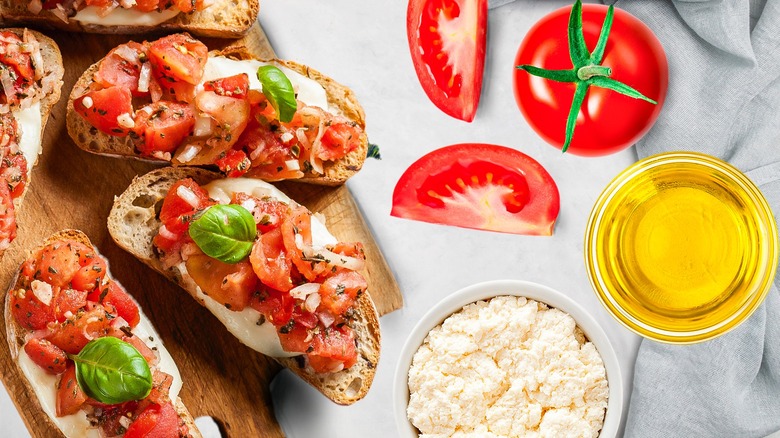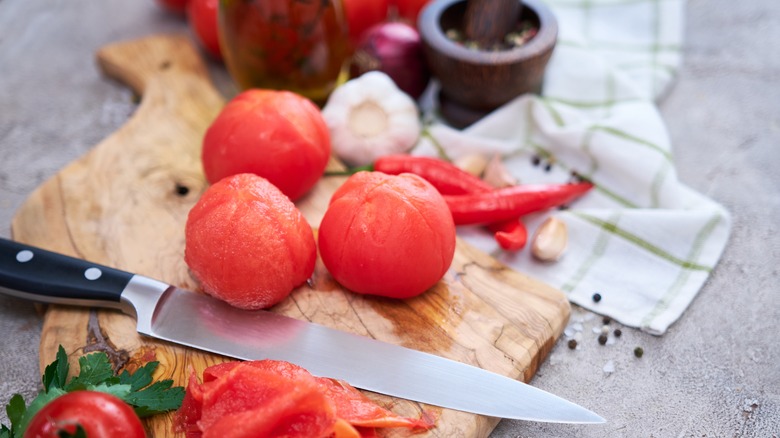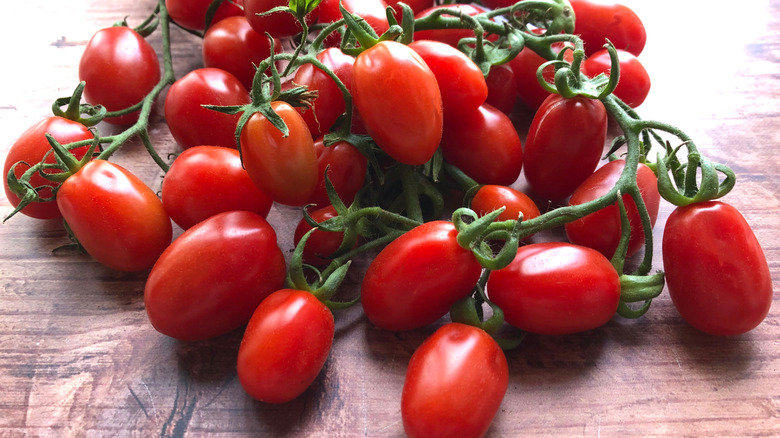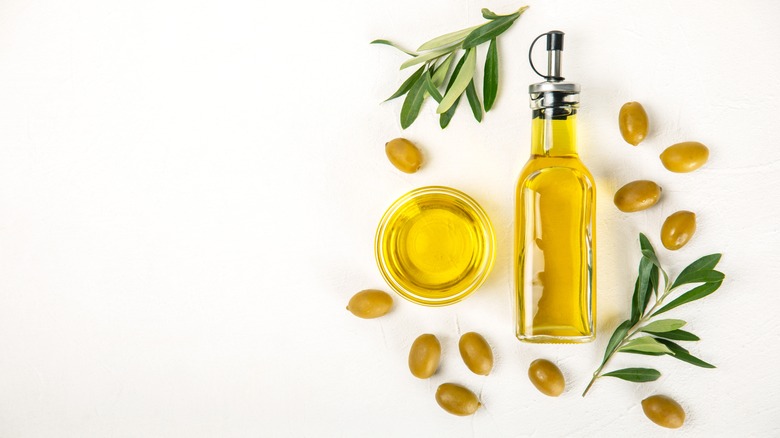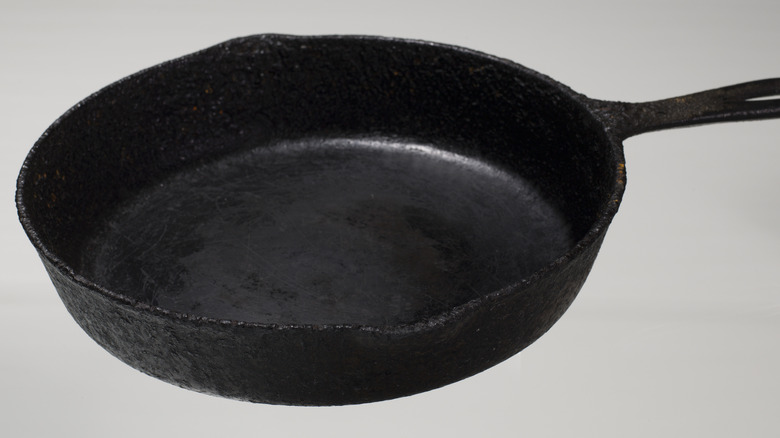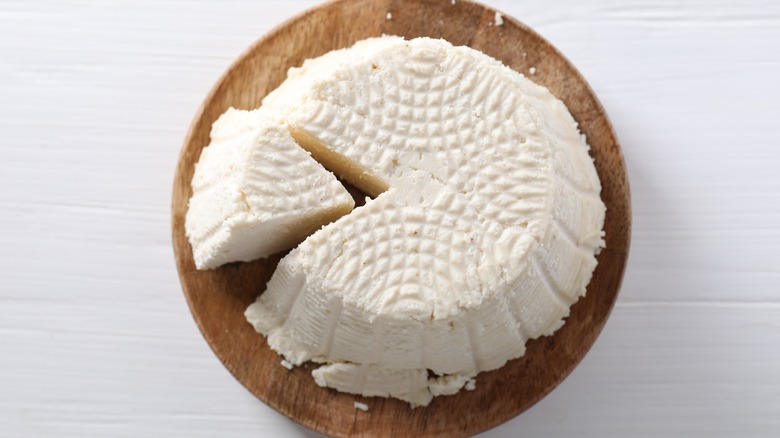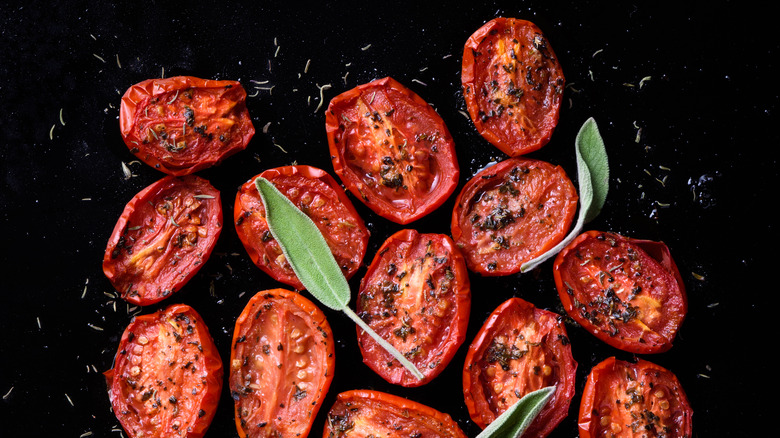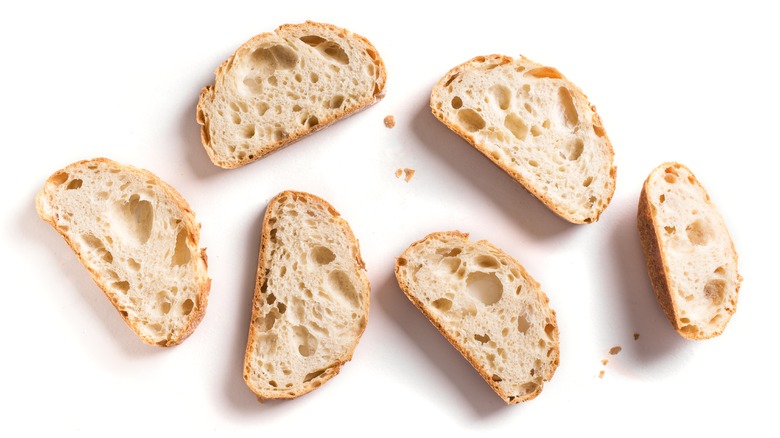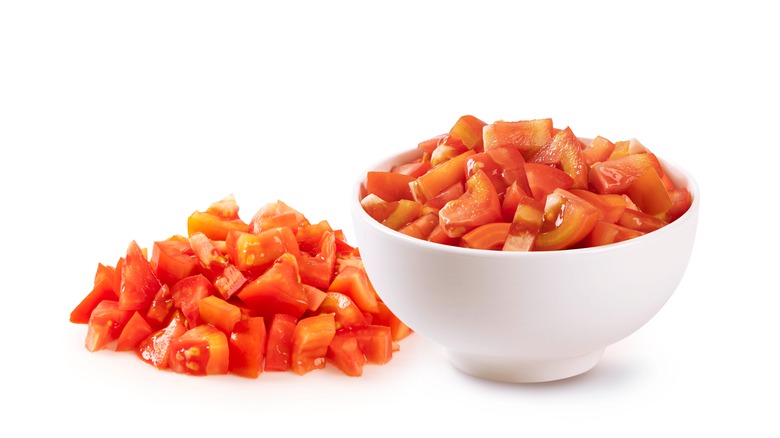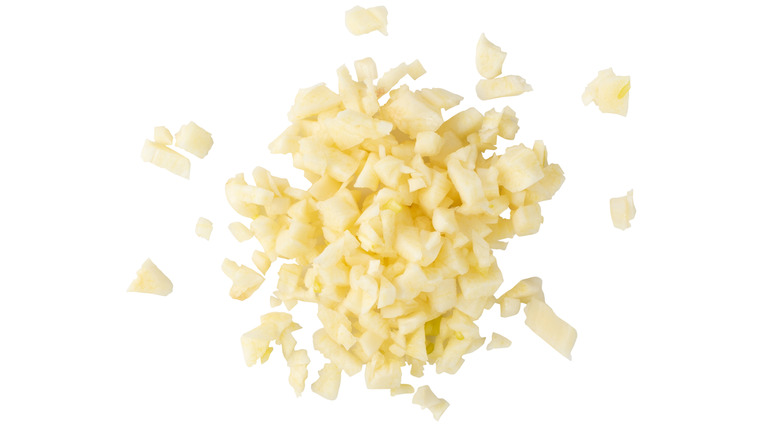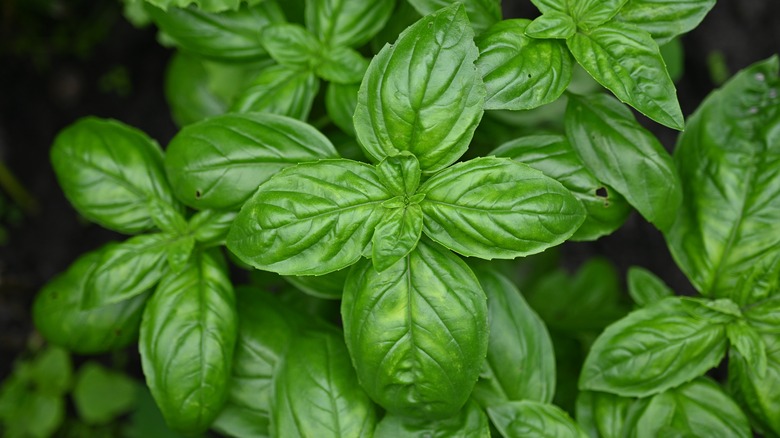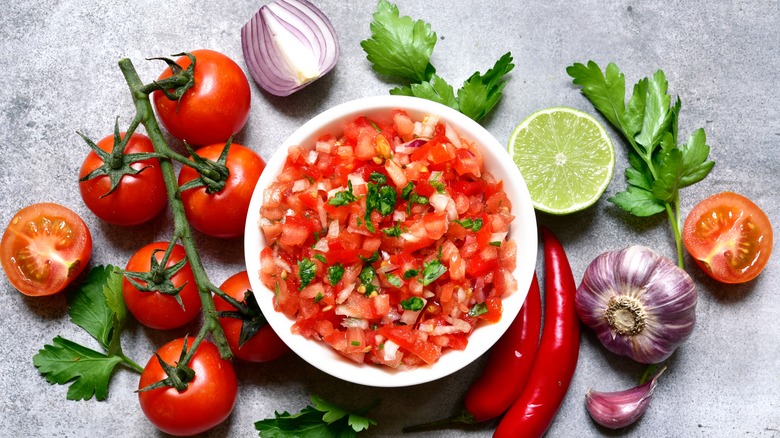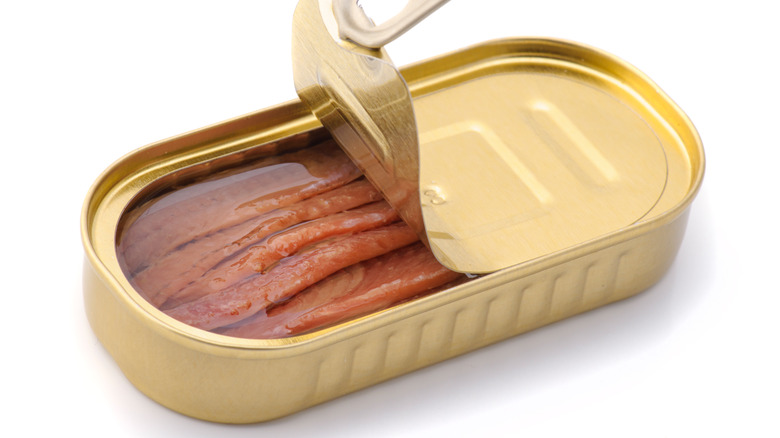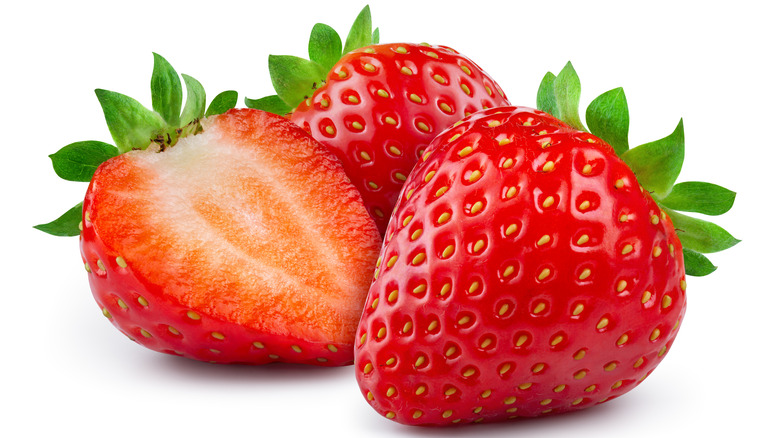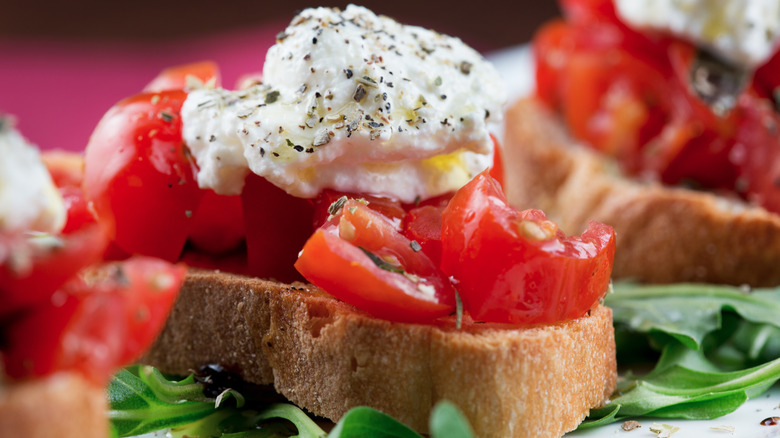14 Tips For Making The Ultimate Bruschetta
Before we delve into bruschetta, let's get one thing straight: the pronunciation. Many English speakers across the world pronounce this popular Italian appetizer as bru-shetta (like brush), with an emphasis on the "sh" sound. However, this is all wrong, and it drives Italian speakers (or this one, at least) mad. In fact, the correct pronunciation for bruschetta is bru-sketta (as if it's spelled with the letters "sk"). Now that we've gotten that out of the way, we can discuss the actual dish.
Classic bruschetta starts with a base of grilled or toasted bread, typically a crusty, country-style loaf. The bread is often rubbed with garlic cloves to impart a subtle, aromatic flavor, though the cloves can also be diced and mixed in with the tomatoes, fresh basil, salt, and olive oil that top the bread. This simple combination showcases the freshness and quality of each ingredient, making bruschetta an ideal summertime appetizer (that's when tomatoes are in season, after all).
Of course, despite this simplicity, it's not always easy to prepare a perfect bruschetta. But I'm here to help. As a longtime resident of Italy — who's lived in the country and made authentic bruschetta since childhood — I've got a lifetime of experience to draw from with this famed Italian appetizer. I've gathered some of the top ideas to remember when preparing this dish, along with some unique suggestions to potentially tweak and improve it. Without further ado, here are 14 tips for making bruschetta.
Blanch the tomatoes before peeling them
Finding bits of tomato peel in your food isn't everyone's cup of tea, especially with bruschetta. In fact, tomato skin — which is thin and almost imperceptible on an unsliced tomato — starts to become a real nuisance atop bruschetta. When large tomatoes (such as heirloom or vine) are cubed for the dish, the skin starts to take on a mind of its own. It might adhere to the tomato pulp, or go rogue and float around the mixture before getting caught in your teeth. The best thing to do before starting bruschetta, then, is to blanch the tomatoes.
Since the heat from boiling water naturally separates it from the pulp, blanching allows you to easily remove the skin from a tomato. Just be sure to limit yourself to no more than 10 seconds of blanching. After all, you usually want the tomatoes to remain raw with traditional bruschetta to enjoy their full flavor while in season (which is really the only time you should be making it). Once the tomatoes are removed from the water, simply strip the skin away, dice them up, and you're ready for a peel-free bruschetta.
Use different types of tomatoes
One way to counteract a potential tomato skin problem is by selecting a different type. Plum tomatoes, such as the famous San Marzano, are a popular choice since the riper a plum tomato gets, the better it tastes. This type of tomato is relatively small, as well, so when you dice it up, the skin tends to remain taught and fresh, and adheres to the pulp rather than getting loose in your appetizer.
Actually, when it comes to bruschetta, smaller tomato varieties might be the best way to go. For instance, cherry tomatoes, which tend to be sweeter, make an excellent choice. Their subtle combination of sweet and acidic can provide a major flavor boost to this simple dish. Another great option is datterini tomatoes, which are another variety of plum tomatoes. The name means "little dates," and refers to the tomato's shape and sweet flavor. Datterinis behave in much the same way as cherry tomatoes and are just as sweet (if not more).
Another perk is that datterini tomatoes come in both red and yellow, which means you can play around with the colors and mix it up. Use yellow datterini tomatoes for a sunny-looking bruschetta plate, or combine them with the red ones for an extra pop of color. Either way, the flavor doesn't change.
Select a high-quality olive oil
Because there are so few items in bruschetta, choosing high-quality ingredients for any recipe is crucial. With that in mind, the most important ingredient to consider aside from tomatoes (which should be in season and full of flavor) is the olive oil. After all, the wrong kind can lead to a tasteless mess or a somewhat bitter result.
First off, you'll want to focus exclusively on types of extra virgin olive oil for bruschetta, as other varieties of olive oil are more likely to yield a flavorless blob. Extra virgin olive oil, though, is the purest kind with the most intense flavor, and it's everything your bruschetta tomatoes deserve. It's also worth purchasing olive oil sold in a glass bottle. Oil is corrosive to plastic, so it could potentially leech into the product (diminishing the quality and taste).
Additionally, you should look for a "bottled date" that falls within the past 18 months, particularly with cold pressed extra virgin olive oil. Anything older risks developing a rancid taste that can taint your bruschetta mixture and ruin the flavor. If you're unsure where to turn to for a good bottle, consider finding some inspiration among Tasting Table's list of the best olive oil brands.
Use a cast iron skillet for the bread and tomatoes
The famed cast iron skillet can do practically anything in the kitchen. So it stands to reason that it can make excellent bruschetta, as well — as long as you're willing to stray from the classic recipe that only uses raw tomatoes. In fact, when making a cast iron skillet bruschetta, you'll want to start by cooking the tomatoes along with garlic and olive oil until they're nice and juicy.
Now, at this point, it's time to remove the tomatoes and move onto the bread, which is where this recipe gets interesting. You'll want to leave some of the juices in the pan before toasting the bread, which will infuse your bruschetta with an additional flavorful base. Be sure to select a hearty bread for this bruschetta variation, as you'll need to toast it for at least four minutes on each side to ensure it doesn't become soggy. A nice artisanal sourdough should do the trick.
Combine your bruschetta with ricotta
Another way to provide creaminess to bruschetta (if that's your thing) is to spread some fresh ricotta on the bread after toasting it. You can even whip up your ricotta in a food processor with a pinch of salt and some freshly-ground pepper, then adding the mixture to a piping bag. Finally, lay out the whipped ricotta in a pretty pattern onto your toasted bread.
Quite frankly, whipped ricotta just seems to bring an extra level of freshness and vigor that regular ricotta can't quite match. Perhaps it's because of the additional air or the appearance (or both). Either way, once the whipping is done, carefully spoon your bruschetta tomato mixture over the whipped ricotta. Make sure you don't pile it on too heavy or the cheese will get lost in the melee. Complete the picture with some fresh torn basil for flavor and color.
Now, die-hard traditional bruschetta lovers might look down on anyone trying to add cheese to this beloved appetizer. While they'd be right to do so when it comes to harsher cheeses, like cheddar or Swiss, ricotta is light enough to get away with adding. More than that, it brings a new dimension of flavor to the dish without undoing everything that's already great about it.
Roast the tomatoes in the oven
Roasted tomatoes have a lovely smokiness to them which adds a certain depth to a wide range of recipes. With that in mind, if you're willing to stray from the raw tomato rule for bruschetta, roasted tomatoes can lend their unique flavor to this appetizer, as well — especially when paired with balsamic vinegar, like in a roasted balsamic bruschetta recipe.
The roasted tomatoes pair nicely with balsamic vinegar, which provides another layer of flavor with its sweet, caramelized taste. You'll want to roast the tomatoes whole for this recipe with olive oil and garlic for about an hour at 350 degrees Fahrenheit. This way, they'll soften sufficiently and start to caramelize. If you'd like, you can speed up the roasting process by chopping up the tomatoes, as well.
Once they come out of the oven, you want to smash the tomatoes on top of the bread — gently, of course, so they don't explode in your face and burn your skin. This lets the tomatoes release their stores of smoky, garlicky juices onto the bread rather than getting lost in the baking tray.
Don't forget to toast the bruschetta bread
Making bruschetta with a cold slice of bread is fine and all. But you're missing out if you don't first toast that bread with garlic and olive oil. Frankly, as good as a fresh slice of bread can be, it doesn't do justice to the sweet freshness of tomatoes on its own. Bread needs that extra smoky bite only a toaster, oven, or cast iron skillet can provide for bruschetta, so remember to toast your bruschetta bread before serving it to guests.
When it comes to toasting methods, you can go quick and simple with a standard toaster, then brush some olive oil on top after it pops out. Or you can toast bread slices in the oven after drizzling them with olive oil (and maybe rubbing on some minced garlic). This method is especially useful if you have a lot of guests to cater to since larger batches can be made this way.
Plus, an added bonus of this tried and tested rule is that if you don't have fresh bread on hand, you can still use yesterday's loaf. Toasting will revive any day-old baguette, in fact — and your diners will be none-the-wiser. Just don't go for a loaf that's been sitting there for two days or more. It might be hard enough to break someone's tooth by then.
Let the tomatoes drain
Tomatoes are wondrous ingredients, but let's face it: they can be a little watery sometimes. This is especially true if you've blanched them to remove the skin. Luckily, there's an easy solution to this watery problem, and one you might want to consider when making bruschetta. Simply drain the tomatoes until you're satisfied that most of the water has come out (but not so long that the tomatoes no longer have any juiciness left).
Start by dicing the tomatoes as you normally would for bruschetta. Next, place them in a colander in the sink or over a bowl (to keep the escaping juices from running all over your counter), and add salt to help the tomatoes release their water. While many recipes that call for this step suggest only leaving the tomatoes out for about 15 minutes or so, you can let them sit for longer if you feel they're still too watery. It would take a very long time for all of the juices in a tomato to drain off, so you should be safe for at least an hour or so.
Additionally, be sure to wait to add olive oil until after the draining is complete. You wouldn't want to lose that expensive and delicious extra virgin olive oil you took so many pains to pick out, after all, so be patient while the tomatoes drain before assembling your bruschetta.
Use plenty of garlic
Plain tomatoes are quite good on their own, but their flavor seems to become turbocharged once you add garlic. Consequently, you should never forget this ingredient when making bruschetta. In fact, garlic is so important to bruschetta that if you're ever in doubt as to how much garlic to add, it's best to err on the side of more. For the best results, you can mince garlic and mix it with the tomatoes themselves. Although many traditional recipes call for the garlic to be rubbed onto the bread, this step ensures the flavor permeates through every bite.
If you don't like garlic, you can always skip these steps, but you may want to find alternative methods to boost the flavor in its absence. Drizzling balsamic vinegar can help, as can roasting the tomatoes. Both of these options will deepen the flavor of the tomatoes while adding a slight bite to the mixture, which would otherwise be provided by the garlic.
Add a touch of basil
Italian foods seem to love replicating the red, white, and green colors of the nation's flag at every turn. Think pizza with red tomato sauce, white mozzarella, and green basil, or pasta with red tomato sauce and green oregano. Of course, there's also the red tomatoes on bruschetta made with white bread and green basil (again). This isn't a purely aesthetic or patriotic choice — it's mostly about the flavor that's conferred on the dish. In that sense, a touch of basil is essential to increasing the lightness and freshness of bruschetta (especially when you're using raw tomatoes).
Since the basil isn't merely a decoration, don't just daintily place a whole leaf on top of your prepared bruschetta to improve the presentation. You'll need to get down and actually mince those leaves into smaller bits and pieces to help release the most amount of flavor. After this, be sure to thoroughly mix it into the tomatoes to provide an even flavor throughout the dish.
Turn it into a salad
The tomatoes prepared for bruschetta can be enjoyed in all sorts of different ways — not just on toasted bread. Indeed, they can form the great basis for a raw tomato sauce to be served with pasta, or you can toss the bruschetta components into a salad with plenty of leafy greens. This will help bulk out the dish while flavoring it with its garlicky goodness, as well. Or you can turn the whole thing into a salad and eat it on its own.
In this case, you might want to add a few more ingredients to make it interesting. For instance, this bruschetta caprese recipe makes it clear that the bread — while a great accompaniment to the tomato mixture — isn't entirely necessary. That makes it a great option for people who adhere to a gluten-free or low-carb diet. As the name suggests, you can also add diced mozzarella to your tomatoes along with olives, oregano, and the rest of the usual bruschetta gang. The result is bulky enough to constitute its own salad meal.
Add flavor with anchovies
Anchovies are famous for lending their flavor and saltiness to all sorts of dishes. That includes tomato sauce, with anchovies used in various recipes like pasta puttanesca. However, you can also use the canned fish to add flavor to a raw, tomato-based dish such as bruschetta. One recipe in particular seems to work especially well with this mighty little fish: bruschetta with yellow datterini and oregano.
For this one, start by making your usual bruschetta mixture with tomatoes, salt, basil, and (possibly) garlic, then add a few filets of anchovies to the fray. After toasting your bread, top it with the mixture and serve. Alternately, you could lay out the anchovies on your toasted bread and top them with the tomato mixture. You may want to spread the anchovies over the bread with a spoon or knife to make sure the flavor and oils sink in a little, as well, without causing the bread to soften too much.
Go off-book by adding fruit
The vast majority of bruschetta recipes you see in America and across Europe are made with red tomatoes. But given the rise of fruit used in savory dishes — especially fresh, summertime meals — that may be about to change. Famous Italian-American chef Giada de Laurentiis uses fruit in at least two of her bruschetta recipes, for instance, where strawberries and peaches are the stars of the show.
In the first recipe, de Laurentiis uses strawberries along with cherry tomatoes, honey, and balsamic vinegar. This creates a deeper contrast between the naturally sweet and acidic elements of typical bruschetta. Strawberries are a nice touch here because of their flavor, and because their red color keeps the recipe's traditional visuals intact.
Similarly, in the celebrity chef's other fruit-focused bruschetta, peaches and corn appear to match the color scheme of bruschetta made with yellow tomatoes. The burrata supplies a creamy foil to the fresh fruit here, while a spicy kick from the Fresno chiles is also welcome.
Never assemble bruschetta ahead of time
It may seem tempting to prepare a bruschetta appetizer before your guests arrive, and save yourself the stress of hectically dishing up the tomato mixture for a dozen people at once. But that's not how bruschetta works. The term "bruschetta" refers to the bread, after all (not the topping), which comes from the word "abbrustolito" meaning toasted. The word's origin underscores the need for the bread to be crunchy, so preparing the appetizer ahead of time isn't really an option at all.
Topping toasted bread with juicy tomatoes long before anyone is going to eat it will only soften the toast. It'll end up absorbing the water, undermining a key quality of this dish. Given this, it's essential to serve bruschetta immediately after placing the tomato mixture on top.
Now, if this is causing you so much anxiety that you've decided to cut bruschetta entirely from your next dinner party menu? Think again. Part of the joy of bruschetta is that everyone can serve themselves whenever they want. With this in mind, you don't need to individually serve anyone bruschetta. Rather, just place a big bowl of the mixture in the center of a serving plate, lay the toasted bread slices around it, and allow your guests to take care of themselves.
